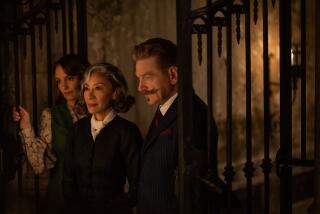The secret of the missing thrill
- Share via
If you grew up reading Nancy Drew mysteries, your pulse may quicken to hear that Simon & Schuster is publishing a new, updated series.
The new books will awaken fond memories. Bess Marvin and George Fayne are still Nancy’s close chums. Ned Nickerson remains her “special friend,” although his activities include reading rather than quarterbacking. Nancy’s father, Carson Drew, is still a hotshot lawyer, and housekeeper Hannah Gruen continues to fret over Nancy’s safety (albeit with considerably less cause in today’s books). The pseudonymous author’s moniker is still Carolyn Keene.
Throngs of little girls -- me included -- stayed up past bedtime reading the books with flashlights under the covers. The first book was published in 1930, and additional volumes have been rolling off the presses at a steady rate since then.
Brush aside the nostalgia. What do you really remember about the teen-girl sleuth?
She was hit on the head more times than a prizefighter. Bad guys were forever gagging her and tying her up. She took the law into her own hands rather than going to the proper authorities. She sped around town in a little blue roadster. And the spunky little terrorist even used dynamite to destroy property. Volume after volume contained frightening images, unsafe adventures and dicey characters. Is this the kind of literature you want to invade the impressionable brains of young children?
If you worry about that, there is some good news -- and splendid news.
First the good news. The classic books are effectively out of circulation. Unless they’re stashed in boxes in your basement, be heartened that it takes some work to get hold of this potentially traumatic material.
Now the splendid news. The new volumes have been stripped of most of the aforementioned perils. Cliffhangers, tension and suspense that kept children reading have been replaced with low-carb modern slop.
Kids can’t possibly get into trouble reading this stuff. Unless, of course, they fall into a fatal coma from utter boredom. Or, more likely, they plod through a few chapters, then scrap reading altogether in favor of a gunslinging, soft-porn, video-game-inspired action flick. But the few kids who can stick it out -- they’ll be kept safely in a literary padded playpen.
Consider this: In “Without a Trace” (Simon & Schuster, 150 pages, 99 cents), the first book in the new series, the nouveau Nancy is charged with uncovering the identity of someone who tramples neighborhood zucchini patches. “Are you really so desperate for a mystery that you’re going to investigate this?” asks Fayne.
Later in the story, a Faberge egg disappears and Nancy is back on familiar ground -- searching for a missing valuable item. But in the old days she’d have started receiving threatening messages from people telling her to drop the hunt. Now the most uncomfortable situation she runs into is when she falsely accuses a suspect at a party.
She never gets tied up, as she did so often in the older volumes. In four new books, Nancy’s life is threatened only once -- and this is due to her own clumsiness. In “High Risk” (146 pages, $4.99), she accidentally knocks out the pilot of a plane she’s flying in.
How could the original series have been so -- rough?
The first Nancy Drew book was published in 1930, a scant 10 years after women had received the right to vote. The nation was beset by a deep depression. Financiers weren’t regulated. Politicians weren’t regulated. With all this going on, what could anyone expect from Nancy Drew?
Today, companies publish ethics policies and provide employees with sensitivity training. Members of Congress answer to ethics committees. They fly economy class and vote against increasing their own salaries -- just so they look good to the voters. And, just like the leaders of our society, the nouveau Nancy Drew is keeping up appearances. She knows not to do anything too scary or shocking.
After 175 Nancy Drew books, it is fair to wonder why there is even a need for new volumes. The answer is financial. There has been more interest in her as a brand, according to Simon & Schuster. And next year is Nancy’s 75th anniversary, which, if her 50th was any guide, will generate lots of media attention.
The goal of the new books is to expand Nancy’s fan base, Simon & Schuster says, and “High Risk” made it to the New York Times’ children’s bestseller list, undoubtedly preying on parental nostalgia.
But Nancy Drew has always been a cash heifer. When turn- of-the-last-century publishing baron Edward Stratemeyer created the series, he wanted money, not fame. In fact, he was not a fan of Nancy Drew. After reading the original manuscript, he “expressed bitter disappointment ... saying the heroine was much too flip, and would never be well received,” according to Mildred Wirt Benson, the first of many Nancy Drew authors.
So, at the time, Nancy Drew occupied a lonely place in the literary world. “The plots provided me were brief, yet certain hackneyed names and situations could not be bypassed,” said Benson in a biographical essay quoted in the New York Times. “I concentrated upon Nancy, trying to make her a departure from the stereotyped heroine ... in the series books of the day.”
Ironically, the same can be said of the new books. But now the female action figure is a cliche, and Nancy is a safe distance from the real action.
More to Read
Sign up for our Book Club newsletter
Get the latest news, events and more from the Los Angeles Times Book Club, and help us get L.A. reading and talking.
You may occasionally receive promotional content from the Los Angeles Times.










